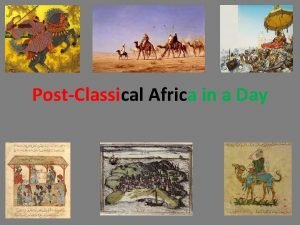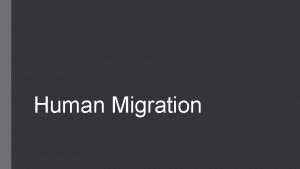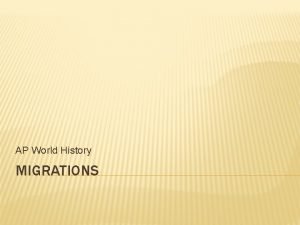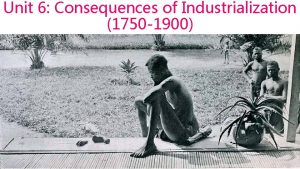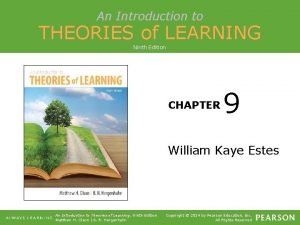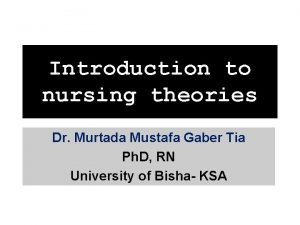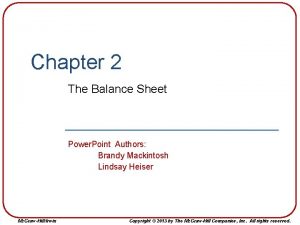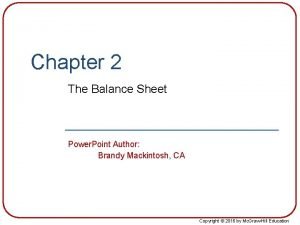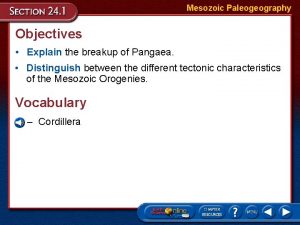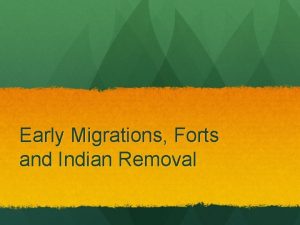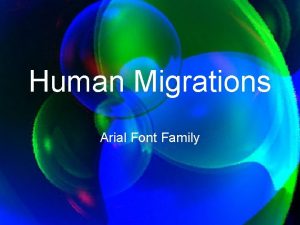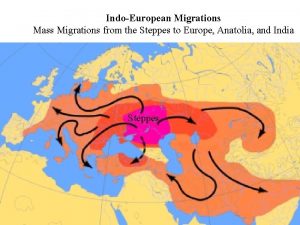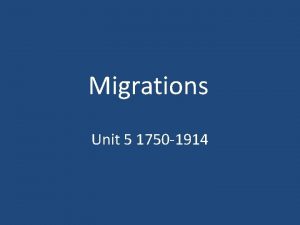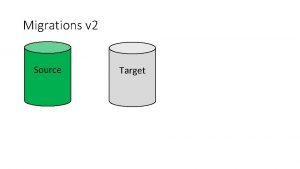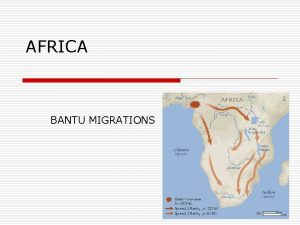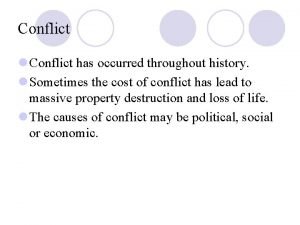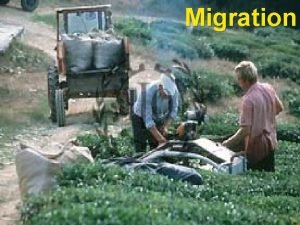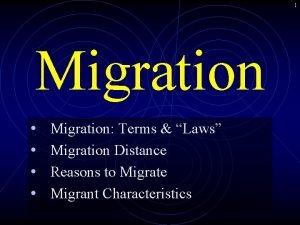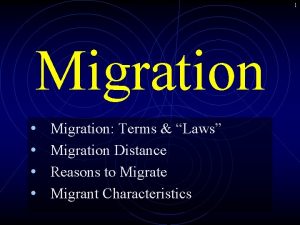Theories of Migration Introduction Migrations have occurred throughout


















- Slides: 18

Theories of Migration

Introduction • Migrations have occurred throughout human history, beginning with the movements of the first human groups from their origins in East Africa to their current location in the world.

Continued- • Migration occurs at a variety of scales: intercontinental (between continents), intercontinental (between countries on a given continent), and interregional (within countries). One of the most significant migration patterns has been rural to urban migration—the movement of people from the countryside to cities in search of opportunities.

Definitions Ø WHO; The movement of a person or a group of persons, either across an international border, or within a State. It is a population movement, encompassing any kind of movement of people, whatever its length, composition and causes; it includes migration of refugees, displaced persons, economic migrants, and persons moving for other purposes, including family reunification.

Continued-Ø Movement of people to a new area or country in order to find workorbetter living conditions. Ø The process of permanently changing residence from one geographic location to an other.

Theories of Migration Two broad theoretical streams : q Models examining the initiation of migratory movements q Models analyzing the perpetuation of such movements across space and time

Neo Classical Macro Theory Key Proponents: Lewis, 1954; Ranis & Fei, 1961; Harris & Todaro, 1970; Todaro, 1976 Key Propositions : �Migration of workers is caused by differences in wage rates between regions

Continued-�Labor markets are the primary mechanisms by which migration of labor are induced – other markets do not have important effects on migration �The way for governments to control migration flows is to regulate or influence labor markets in sending and/or receiving countries

New Economics of Migration Theory Key Proponents: Stark & Levhari, 1982; Stark, 1984; Stark & Bloom, 1985; Katz & Stark, 1986; Taylor, 1986; Stark, 1991 Key Propositions : • Families, households or other culturally defined units of production and consumption are the appropriate unit of analysis for migration research, not the autonomous individual.

Continued- • Wage differentials is not the necessary condition for any migration to occur; households may have strong incentives to diversify risks, through migration even in the absence of wage differentials. • Government can influence migration rates not only through policies that influence labor markets, but also through those that shape insurance markets, capital markets etc.

Dual Labor Market Theory Key Proponent: Piore, 1979 Key Propositions : q Migration stems from intrinsic labor demands of advanced regions

Continued-q Labor migration is largely demand based and is initiated by recruitment on the part of the employers in advanced regions or by governments acting on their behalf. q Wage differentials are neither a necessary nor an essential condition for labor markets to occur,

World Systems Theory Key Proponents: Wallerstein (1974); Portes and Walton, 1981; Petras, 1981; Castells, 1989; Sassen, 1988, 1991; Morawska, 1990 Key Propositions �Migration is a natural consequence of capitalist market formation in the developing/backward regions; the penetration of the global capital into peripheral regions is the catalyst for movement

Continued-�Flow of labor follows the flow of goods and capital, but in the opposite direction �Migration ultimately has little to do with wage rates or employment differentials between regions; it flows from the dynamics of market creation and the structure of the global economy

Network Theory Key Proponents: Hugo, 1981; Taylor, 1986; Massey, 1990; Gurak and Caces, 1992 Key Propositions: �Once begun, migration tends to expand over time through network connections

Continued- • �As migration becomes institutionalized through the formation and elaboration of networks, it becomes progressively independent of the factors that originally caused it, be they structural or individual

Continued-�Governments can expect to have great difficulty controlling flows once they have begun, because the process of network formation lies largely outside their control and occurs no matter what policy regime is pursued

Institutional Theory Key Proposition �As organizations develop to support, sustain, and promote movement, the flow of migrants becomes more and more institutionalized and independent of the factors that originally caused it.
 Slavic migrations
Slavic migrations Bantu migrations
Bantu migrations Types of migrations
Types of migrations Types of migrations
Types of migrations Les causes de la migration bantu
Les causes de la migration bantu Bantu migrations definition
Bantu migrations definition Convict food
Convict food Pentagonal prism vertices
Pentagonal prism vertices An introduction to theories of learning
An introduction to theories of learning Classification of nursing theories
Classification of nursing theories Satyam scandal 2009
Satyam scandal 2009 What type of mutation occurred?
What type of mutation occurred? The following events occurred for favata company
The following events occurred for favata company The following events occurred for favata company
The following events occurred for favata company The breakup of pangaea occurred during the
The breakup of pangaea occurred during the Human outputs
Human outputs Tsering family
Tsering family Indicates a mouse action occurred in a component.
Indicates a mouse action occurred in a component. An unexpected directx error occurred present failed
An unexpected directx error occurred present failed

